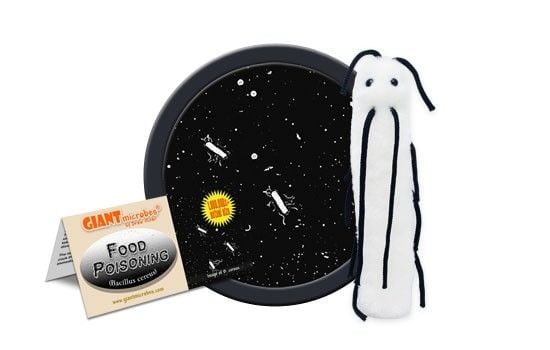Food Poisoning (Bacillus cereus)
Out of Stock
Product Details
Additional Information
| Sizes | Giantmicrobes are based on actual microbes, cells, organisms and other critters, only 1,000,000 times actual size! Gigantic (GG) 40-60cm XL (XL) 25-38cm Original (PD) 12-20cm Minis (MM) 5-10cm each Keychain (KC) 5-10cm with clip |
|---|---|
| Materials | Plush from all new materials. Stuffed with polyester fiber fill. Surface washable: sponge with water & soap, air dry. |
| Packaging | Each plush microbe includes a printed card with fun, educational and fascinating facts about the actual microbe or cell. |
| Safety | Every product meets or exceeds U.S. and European standards for safety. For ages 3 and up. |
All about Food Poisoning (Bacillus cereus)
FACTS: Although there are many causes of food poisoning (including numerous viruses and bacteria, not to mention toxins and pesticides), Bacillus cereus is one of the common ingredients found in spoiled food – and the indigestion caused by its ingestion can certainly be serious!
There are two primary types of B. cereus-related illness, categorized according to whether the poisoned food ultimately goes out up or down. While the diarrheal form can be induced by the presence of B. cereus in any number of infected food (including milk, meats, vegetables, and fish), the emetic (vomiting) variety is most typically the result of eating contaminated rice (or other starchy products), such as are often served in Chinese, Mexican, and other fast food restaurants.
The problem is that B. cereus spores are often present in uncooked rice. But because the spores are heat-resistant, they are not always killed when the rice is cooked, particularly if it is steamed or cooked too quickly. Then, if the rice is kept warm, or allowed to cool to room temperature slowly before refrigeration – as is often the case with foods made for take-out or delivery – B. cereus can rapidly multiply until it is present in disease-inducing concentrations.
The lesson: when it comes to rice and other starchy foods, it’s important to cook them thoroughly, eat them while they’re fresh, and refrigerate leftovers immediately. If you don’t, your fortune could turn seriously bad in a hurry.
| Name | This microbe was placed under the Bacillus genus because of its rod shape and its ability to form spores. Cereus is the Latin root word for “wax”, which describes the waxy appearance of its colonies on agar plates. |
|---|
| Actual Size | 1 x 3 micrometers |
|---|
| Where It Lives | Bacillus cereus is a bacteria commonly found in soil. It causes food poisoning when people eat contaminated foods like meats, sauces, soups, or vegetables that haven’t been stored properly. They multiply quickly and produce toxins that cause diarrhea and vomiting. The FDA recommends that everyone B. cereus when it comes to proper food handling! |
|---|
| Symptoms | Symptoms include stomach ache, vomiting, and diarrhea that starts within 8 hours of eating contaminated food, and lasts for about 24 hours. |
|---|
| Cure | Drink lots of water to stay hydrated. This disease is usually self-limiting, which means the immune system can fight it off within a day. |
|---|
| History |
First discovered in 1880 Big Outbreaks: 1950: several outbreaks occurred all over Europe from contaminated meats, vegetables, and dairy products. Recent Outbreaks: Since 1990, it’s become the most common microbe associated with foodborne illness. |
|---|
| Fascinating Facts | This microbe is closely related to the bioterrorism agent, Bacillus anthracis, or anthrax! |
|---|






